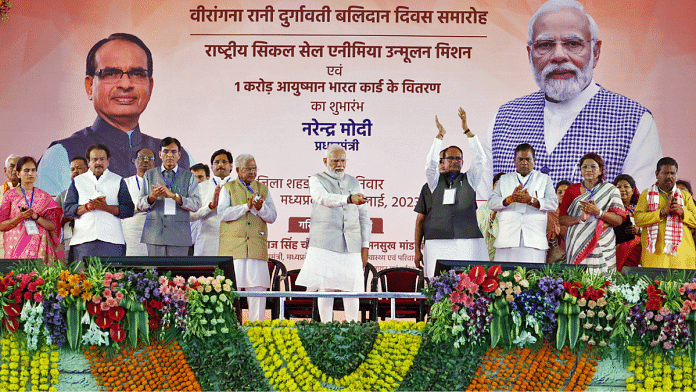In India, one in every 86 people belonging to the Scheduled Tribes is born with a congenital deformity in red blood cells known as sickle cell anaemia. A programme targetted at addressing this problem seems to be the lowest hanging fruit, yet India’s National Sickle Cell Anaemia Elimination Mission was launched only on 1 July 2023 by Prime Minister Narendra Modi in Madhya Pradesh.
There is another blood disorder against which India has waged a long war with mixed results — anaemia. Like its sickle cell cousin, anaemia, too, affects individuals in India selectively — analysis of incidence data has consistently shown that it is observed more among women and children belonging to STs and Scheduled Castes (SCs) than those from the general categories, yet there have been no targeted interventions for controlling the disease in these groups.
To that extent, the sickle cell programme is something of a trendsetter. It will conduct population-based screening, prevention, and management of sickle cell anaemia in all tribal and other areas where the condition is most prevalent. Screened individuals will be handed a card that can be used to predict their likelihood of having an offspring with the disease.
Also read: PMJAY must step on the gas—slow expansion hurts India’s ‘missing middle’
The scale of the issue
Home to 20 million patients afflicted with sickle cell anaemia, India has the highest prevalence of the disease in South Asia. This figure is only a fraction of India’s massive burden of anaemia. About 57 per cent of women and 21 per cent of men in the 15-49 age group are anaemic, according to the National Family Health Survey (NFHS-5) 2019-21. Sickle cell anaemia is part of the burden. Moreover, the figures have stubbornly stayed around the same levels for the last three surveys. In NFHS-3, the figures for women and men in this age group stood at 56.2 per cent and 24.2 per cent, and in NFHS-4 the numbers were 53 per cent and 23 per cent.
The discussion around the recalcitrant nature of India’s anaemia burden has stretched into several decades now. The country has always had an anaemia programme since 1970 when the National Nutritional Anaemia Prophylaxis Programme was launched. What remains less known is the fact that like sickle cell disease affects tribals at a higher rate, anaemia too has a caste/tribal bias.
Earlier this year, researchers from Delhi’s Jawaharlal Nehru University (JNU) and their associates published an analysis of India’s anaemia burden by looking at the data from the last three national family health surveys. They concluded that in most states, the incidence of anaemia among SC, ST, and Other Backward Classes (OBC) women is higher than that in women from general categories. “In India, more than 15 states belong(ed) to the high prevalence (>%55) of anaemia among socially backward groups in 2019–21. The anaemia prevalence was high (>55%) in all social groups (SC & ST, OBC, general) observed in 7 states in NFHS-3, 4 in NFHS-4 and 11 states in NFHS-5,” they wrote in their paper published in PLoS One.
In a 2015 study published on BMC Public Health, researchers from the University of Glasgow and the University of Groningen also reached the same conclusion on childhood anaemia, describing caste as an “independent determinant” of the condition.
Also read: India challenges WHO global modelling estimates for TB, is first to develop own model
Identifying the problem
The ambitious Anaemia Mukt Bharat programme, which was launched by the Modi government in 2018, has a 6x6x6 module — six beneficiaries, six strategies, and six institutional mechanisms. But it lacks targeted intervention on caste-based lines, something that the NSCAEM is attempting for STs. In India, as is evident from the survey data, the anaemia burden transcends social boundaries — even urban, educated, affluent women rarely qualify as blood donors as it requires one to have a Hb count of 12 or more. There are also the added challenges of vegetarianism, especially in the central Indian belt, and the propensity of iron and folic acid prescription (one of the six strategies under Anaemia Mukt Bharat) for anaemic individuals without any meaningful look at the protein content of their diets. Haemoglobin is a compound of iron and protein. Supplementing just one is not enough.
Nevertheless, a one-size fits all universal approach to tackle anaemia does not seem to be working for India. The last three family health surveys also show that between NFHS-4 and NFHS-5, the number of anaemic people in India went up. Whether that is linked to the hardships inflicted by Covid-19 and the ensuing lockdowns is a matter of debate, but the link between poor nutrition and anaemia is fairly well-established as is the fact that hunger and poverty affect the socially backward more than others. According to the 2021 Multidimensional Poverty Index developed by the United Nations, five out of six “multidimensionally poor” people in India either belonged to ST or SC groups. Multidimensional poverty looks at health, education, and standard of living. The two parameters that were analysed under the health category were nutrition and infant mortality.
Notwithstanding the Modi government’s criticism of the 2022 Global Hunger Index, in which India ranked 107 out of 121 countries, it is fairly well-documented, including in successive family health surveys, that irrespective of the availability of food, malnutrition remains a persistent challenge for the country.
However, for reasons best known to the political class, affirmative action for these groups has largely been limited to reservation in education and jobs and little to no attempts to address other deficiencies that these groups live with.
The latter may be worth exploring if we are to truly move toward a country that is anaemia-free.
Abantika Ghosh is a former journalist and author. She is currently working with Chase India. She tweets @abantika77. Views are personal.
(Edited by Humra Laeeq)



